PURPOSE This study aims to analyze research trends on the social capital in sports. METHODS A total of 69 papers published until December 2020 were selected as research subjects. Further, Excel, KrKwic software, and NetDraw function of the UCINET 6 program were used for analysis. RESULTS First, social capital research on sports has shown quantitative growth since 2010. Second, the studies were conducted on sports participants such as general, elderly, college students, adolescents, foreigners, and the disabled, showing the highest frequency of research subjects. Third, quantitative research conducted based on the research method were several. Fourth, single-author studies were the highest. Fifth, as the result of the analysis on the publication journal, the Journal of the Korean Physical Education Association was shown the highest. Sixth, due to frequency analysis of the thesis keywords, “social capital,” “sports participation,” “action intention,” “social capital type,” “living sports participation,” and “youth” were shown the highest. Seventh, as a result of centrality analysis between keywords through the network analysis, “sports participation” in connection centrality, “health-promoting lifestyle” in proximity centrality, and “sports participation” in mediation centrality were found as the highest. CONCLUSIONS The significance of social capital in sports is more important than others because it is a fundamental element for creating a culture where more people can enjoy sports moderately in Korea, where capitalism and liberal democracy were adopted as the governing system. Therefore, this study can be a vital resource significantly contributing to the understanding and active use of social capital, a significant factor in developing sports in Korea.

Purpose Based on the match data of major judo world competitions in the last five years, this study identifies differences in general characteristics and environmental factors according to scoring technique and scoring times. And by exploring the factors associated with scoring technique, I would like to present a practical strategy that can be used to establish guided tactics. Methods 50,828 points were used for analysis of the entire men and women who competed from 2016 to 2020. Differences in the characteristics of the world's leading athletes according to their types of technique were used in conjunction with the chi-square test and the one-way ANOVA with Sceffe test to produce results. Results The results of this study showed that the type of skill by foot technique was the most common, and the ratio of hand skill to female player to push and foot skill was relatively high. The higher the weight class, the lower the ratio of hand technique, the higher the press rate, and the frequency of skill types also increased. At the Olympic Games, the ratio of hardening technique was higher than that of other competitions, and as the year progressed, the ratio of hand and waist technique increased, and the number of mat-hold decreased. The ratio of hardening technology was relatively high, and the ratio of hand-to-foot technology was relatively high as the semi-final and final rounds were higher. As for technical time, the male athlete's skill time appeared to be about 12 seconds longer on average, with the lowest in the heavyweight class and the longest in the lightweight class. Athletes from the Asian continent appeared to have the longest technical time, which is believed to have resulted from the characteristics of excellent physical strength, good endurance, and strong hardening technique. The skill time leading to the score by pressing and hand skill was the longest, and the waist skill and grip skill time were relatively short. Half of them appeared about 5 seconds shorter on average compared to the first round, and the more important the game (the 4th round, semi-final, and final) the longer the skill time. Conclusion In conclusion, through this study, the characteristics of the world judo players' skill types and time were confirmed, and based on this, it is necessary to analyze and systematize the technical types of the world's best athletes, including Korean athletes, in order to improve their judo performance.



Purpose The purpose of this study was to examine the difference and consistency of kinematic variables for each athlete by selecting the official records of the world's elite female triple jumpers to evaluate the performance level. Methods Three athletes who won the prizes at the World Championships Daegu 2011 Women's Triple Jump were selected as the study subjects, and only the successful trials were used for analysis. Pearson's correlation analysis was conducted with the kinematic variables in the hop, step, and jump phase, respectively. Also, kinematic variables with statistically significant correlations between braking time and pushing time and related variables were described separately. The duty factor and support factor for the hop, step, and jump of support phases were calculated. Results The successful trials rate were 66.7% for Olha, 50% for Olga, and 83.3% for Caterine. In the last three stride distances of the approach run, Olha and Caterine had a “medium-long-short” pattern and Olga had a “long-short-medium” pattern. There was no difference in the duty factor value between hop and jump phases in the ‘hop-dominate’ technique type, but there was a difference in the jump phase in the ‘balance’ technique type, and the duty factor value in the step of both technique types was greater than that of hop and jump phases. As for the percentage of the support factor, Olha and Caterine had a characteristic that the percentage of braking time in step and jump phases was opposite. On the other hand, Olga had the same percentage for the hop and step phase, and a smaller percentage for the jump phase. Conclusion To increase the accuracy of the board touch-down, maintain a certain last stride(1SL) depending on the technique type. This consistency of the approach run increases reduces distance loss on the take-off board and increases the successful rate of each trial. The duty factor can judge both the performance level and the technique type of triple jump, and the support factor is a variable that can classify the technique types of hop, step, and jump phases. If both the relative time required for the triple jump and the variability of the support time(braking and pushing) for each phase are constant, the difference in records by trial will be small.


Purpose The main purpose of this current study is two-fold. Firstly, it attempts to develop a model to determine the true market value of Korean professional baseball players (hitters only) solely based on their athletic performances on the field. Secondly, it is to provide the evidential data for the market value of baseball players in Korea. Methods The statistical data and performance information were obtained from baseball almanac from KBO from 1997 to 2016. Seven hundred and ninety three players were included for data analysis. Principal component factor analysis was utilized to eliminate multicollinearity among 12 sabermetrics indices (OPS, GPA, SECA, TA, RC, RC/27, XR, ISO, PSN, sOBA, %OW, BABIP) and increase power of explanation of the proposed model with KMO(=0.77), p<0.001. Results The proposed model was successfully developed with YSalary = Years of Experience*921.5 + FA (free agent)*53528.9 + PHI(Power Hitter Index)*7313 + CHI(Contact Hitter Index)*5893.6. Furthermore, the proposed model explained 64.5% of variances of the market value for the Korean professional baseball players and proved to be statistically valid. Conclusions The newly developed model in this study was very helpful for us to identify the variables that affect the true market value of baseball players. It is expected that this model could make an important contribution in determining true market value of the baseball players in Korea.

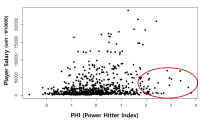
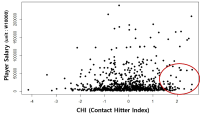
[Purpose] The purpose of this study was to predict winning percentage in the Korean Basketball League(KBL) by applying the possession concept. [Methods] The model to estimate possession was utilized by formula used in NBA(National Basketball Association). Data consist of 20 seasons of the KBL (1997-2017). For data analysis, multiple regression analysis, Fisher’s Z transformation and stepwise multiple regression analysis were performed using SPSS 22.0. [Results] The result indicated that average team stats per possession had more explanatory power in predicting the KBL teams’ winning percentage than average team stats per game. The most important factor for winning in the KBL was defensive rebounds and followed by 2-point field goal percentage, steals, 3-point field goal percentage, free throw attempts, turnovers, offensive rebounds, blocked shots, free throw percentage, and assists. The results of this study provided fundamental information for the data analysis of Korean basketball games. It might be useful for basketball coaches to manage and instruct their teams. [Conclusion] Practical implications and future research direction were also suggested.
PURPOSE This study aimed to analyze factors associated with physical activity (PA) in older adults based on social ecological theory. METHODS Secondary analysis was conducted using raw data from the 2021 Community Health Survey. after excluding 129 non-responses in the PA domain, a total of 74,363 individuals were included in the final analysis. A total of eight factors, including personal (level of depression, history of falls), relational (relationships with neighbors, living alone), community (satisfaction with the local community system, safety), and environmental factors (living environment, natural environment), were selected in accordance with the key points of social ecological theory. To analyze social ecological factors related to the PA of older adults, we conducted a decision tree analysis using Chi-square automatic interaction detection (CHAID). RESULTS The average PA level among older adults was approximately 136 minutes, but the mode and median were both 0 minutes. A total of 20.2% of older adults met the physical activity recommendations, while 79.8% did not. According to the first split of the decision tree, living alone was the most relevant factor associated with the PA of older adults, followed by depression and falls. Older adults living alone, with a depression score of 10 or higher, and who had experienced a fall within the past year, were least likely to meet the PA recommendations. CONCLUSIONS This study urgently suggests that PA programs should target older adults living alone, experiencing depression, and falls.
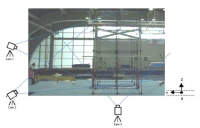
The purpose of this study was to identify the characteristics through technical analysis of dismount to perform the successful landing. The subjects in this study were male gymnastic players of the national team, hish-speed cameras were used to record the salto backward dismount on the parallel bars of the subjects and to study the qualitative and quantitative analysis. The evaluations including feedback of each subjects’problem were as follow: KHH showed early release timing compared to other players. It could be one of factors which can not decelerating the rotational speed, so the correction of posture is needed. NYI didn’t slide to the left at the release phase, and showed big rotation of body compared to other players so the center of mass moved to the rear. The correction of the hand position at flight phase is necessary to perform the V-shaped position. RSD landed in a state where the rotation is insufficient, so the training using elasticity of parallel bars at phase 2, and the correction of hand position are in need. PMS’s rotation angular velocity of body increased consistently, so showed instable land. Therefore the training to ensure the height of flight is required. PEJ showed high vertical position of CM at the release phase which is help for height of flight. He performed ideal V-shaped position, and took a relatively stable landing position. BGR also showed high vertical position of CM and performed ideal V-shaped position, so he landed in a posture in which the most stable. YHS should push vertically rather than horizontally at the moment of release. Especially, the hand position is not on the hamstring but on the back of the knee to perform the ideal V-shaped position. CJY showed little hip angle at the release phase, so he can’t take a position for vertical rise. Also he showed the lowest knee angle and performed rotation and landing in a state that cannot extend the knee. If such problems are corrected, it will be helpful to landing position not only in parallel bars but also in other events.

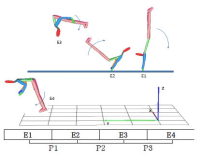
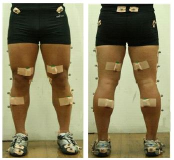
The purpose of this research is to investigate the factors affecting the performance capability of lunge movements by performing lunge movements which are commonly used as a method of instant physical movement in sports with a kinetic analysis including an EMG analysis. This research targeted 14 skilled fencers and made the subjects perform kick-lunges which allow them to go farthest from their positions and performed an analysis on such, applying a 3D motion analysis system and an EMG system. The subjects performed kick-lunges in two movements; one with a preliminary movement and the other without it and those are performed with both dominant leg and non-dominant leg. The result of this research is as follows. The lunges with a preliminary movement showed higher performance capability than those without it. Furthermore, as the level of skills gets higher, the length of lunges gets longer, and it seemed that a tactical mechanism shortening exercise performance times was used as a mechanism to control the impulse coming from such lengthened lunges. In addition, a difference appeared in mechanical factors such as moment and power in a dominant leg movement and it seemed to result from a difference in an functional capability using muscles.


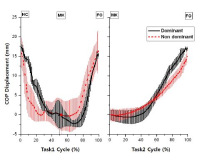


PURPOSE Recreation specialization theory, which is characterized by a unique development process and progress, has been found to have varied pathways that develop in different patterns based on each dimension of recreation specialization. This study aimed to investigate how each sub-dimension of specialization changes as the degrees of experiential participation (frequency, period, and intensity of participation) and goods investment (expenditure) of the scuba divers increase. METHODS In the summer of 2021 (May-August), a purposive sampling method was used to collect samples from young scuba divers, and 278 copies of valid data were used for the final analysis. Frequency analysis, descriptive statistical analysis, confirmatory factor analysis, reliability analysis, correlation analysis, curve estimation analysis, and hierarchical regression analysis were performed using SPSS 24.0 and AMOS 24.0 ver. RESULTS The findings were as follows. First, the quadratic nonlinear model was identified as the optimal model for the relationships between the scuba divers’ participation intensity and cognitive, behavioral, and affective recreation specializations based on experience. Second, the cubic nonlinear model was identified as the optimal model for the relationships between the participation period, frequency of participation, and cognitive, behavioral, and affective recreation specializations of scuba divers. Third, the cubic nonlinear model was identified as the optimal model for the relationships between the expenditure cost of scuba divers and the cognitive, behavioral, and affective recreation specializations in the center of the goods. As the period, frequency, and expenditure of scuba diving participants increased, the relevant cognitive, behavioral, and affective specializations did not progress in a linear manner; instead, they went through an intermediate maintenance stage and developed to a higher level. CONCLUSIONS Progressive and meaningful consumption of experiences and goods further promotes recreation specialization. Any future follow-up study should identify a trade-off point in the development of the recreation specialization in a step by step manner.
PURPOSE This study aimed to: 1) compare the differences in static lower-extremity alignment (SLEA) between female ballet dancers (BD) and non-ballet dancers (NBD); 2) investigate the differences among gesture leg (GL) and supporting leg (SL) in BD and dominant leg (DL) in NBD; and 3) compare limb asymmetry between groups. METHODS Twenty-nine female BD and 20 NBD were recruited for this study. The quadriceps, tibiofemoral, rearfoot, and genu-recurvatum angles, tibial torsion and varum, and navicular drop height were measured. An independent t-test was conducted to compare SLEA and limb asymmetry between groups. One-way analysis of variance with Bonferroni post-hoc tests were performed to determine the differences among the GL, SL and DL. RESULTS BD showed lower quadriceps and rearfoot angles, less tibial varum and navicular drop, and greater tibiofemoral angle (p<.005) than NBD. BD showed less quadriceps angle asymmetry but greater tibial torsion asymmetry (p<.01) than NBD. GL and SL in BD showed differences in quadriceps, tibiofemoral, rearfoot angle, tibial torsion and navicular drop compared to NBD. CONCLUSIONS Repetitive dance movements can transfer varying forces to the GL and SL, potentially contributing to SLEA asymmetry. An intervention strategy that can reduce SLEA asymmetry in BD is needed, as is the identification of elements of ballet training that contribute to maintaining a normal SLEA.